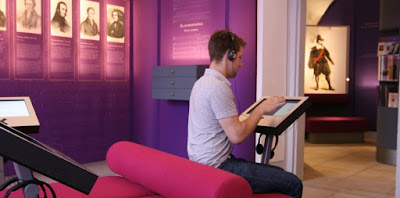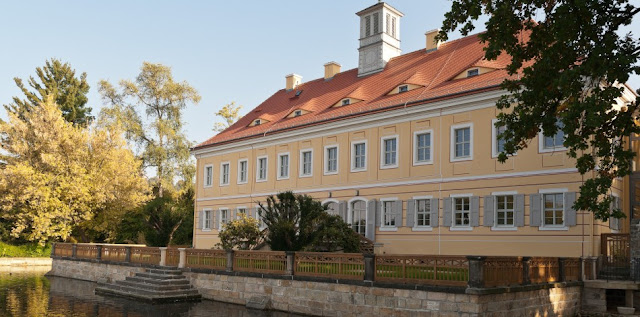 |
| Bust of Wagner outside the Richard Wagner Stätten, Graupa |
 |
| Exploring the music of Wagner and his contemporaries Richard Wagner Stätten |
It starts as you enter the building as a quotation from one of Wagner's operas plays as you enter the porch (a different quotation each time). The first room is the most traditional museum-like, providing background (Richard Wagner was a Saxon, born in nearby Leipzig), complete with an impressive model of the Dresden opera house as it was when Wagner was there.
The next room encourages you to explore Wagner's poetry. A card, given to you when entering the museum, is used as the key to the multi-media exhibits and you choose one of four themes 'Love and Punishment', 'Fear and Courage', 'Transgression and Punishment', 'Enchanted Artefacts', with the themes being a way into exploring Wagner's musical world. The first multi-media display allows you to explore quotations from texts of the operas, starting with your chosen themes. Short texts are displayed and spoken, and these can be explored at greater length (with longer spoken versions), or you can follow links to particular works or dates.
 |
| Exploring the music of Wagner - Richard Wagner Stätten |
The theatre and stage room has images of different approaches to staging Wagner's opera, both period and contemporary. There is also the holographic theatre, where holographic animations of scenes from Wagner's operas are displayed with accompanying music. They are a chance to experience the operas using modern technology but incorporating Wagner's stage directions. So the concluding scene of Lohengrin happens as Wagner's stage directions intended. The descent into Nibelheim from Das Rheingold is rarely staged and here is given an imaginative realisation which follows the thematic development in Wagner's score.
The multi-media exhibition was conceived by the conductor and lecturer Michael Hurshell (conductor of the New Jewish Chamber Philharmonic Dresden). He explained to me that with the holographic theatre's final operatic excerpt, from Der fliegende Holländer, he wanted to show something rarely seen in the theatre. So the singing contest between the men of Daland's crew and that of the Dutchman's ship comes complete with two vessels, and water, with the Dutchman's vessel having the red sails that Wagner wanted.
The orchestra room introduces a new visualisation tool which enables visitors to experiment with an intuitive display which allows them to select orchestral moments from Wagner's works and have different aspects of the orchestration visualised, rhythm, pitch, harmony. It is completely fascinating to listen to a familiar passage and have the orchestration displayed in visual form. And the visualisations look good too.
 |
| Richard Wagner Stätten |
The museum is easily accessible from Dresden, on the end of the 63 bus route and a visit could be combined with a visit to Schloss Pillnitz.
Elsewhere on this blog:
- Musical comedy: Rossini's Il turco in Italia at Garsington - opera review
- Comedy of character: Britten's Albert Herring at the Grange Festival - opera review
- Vividly theatrical: Monteverdi's Il ritorno d'Ulisse at the Grange Festival - Opera review
- Remarkable ensemble: Janacek's Jenufa at Grange Park Opera - Opera review
- Someone once suggested she take a choral contraceptive! I chat to conductor Suzi Digby - interview
- A very complete performance: Don Giovanni from Opera Holland Park Young Artists - Opera review
- Bach orchestral suites: Robert King and the King's Consort - concert review
- From Border-Ballads to Carlyle's Centenary: Christopher Guild plays Ronald Stevenson - CD review
- Bach re-imagines Bach: William Carter in Bach's lute music - CD review
- End of an era: The final Rosenblatt Recital - concert review
- Home


%20Ali%20Wright.jpg)
%20Ali%20Wright.jpg)
.jpeg)
.jpg)
%20and%20Hanna%20Hipp%20(Dinah)%20Credit_%20Genevieve%20Girling%20(4).jpg)



No comments:
Post a Comment